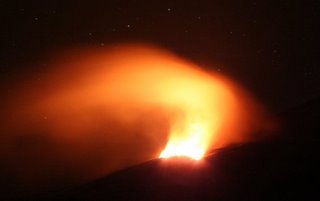
We were just about to give up hopes of getting anything better when a van pulled up and the driver strolled over to talk to us. Being about two miles past the “no access to unauthorised vehicles” sign, we waited guiltily for a lecture on trespass in general and the dangers of wild fires in particular. Instead, the stranger glanced at Miss C’s Canon SLR, currently attached to a large tripod, and invited us to go “somewhere with a much better view”.
Not without trepidation, we started up Miss C’s car and followed our guide – who had not identified himself – deeper into the woods, along ever darker and rougher tracks, at one point crossing a shallow ford. We began to speculate darkly about whether we were being led, or lured, and why he might know so much about where to find the fire…
Eventually, a faint glow appeared above the trees – clearly more than one fire was loose on the mountains tonight, and a deer blundered across the road just in front of us. Now, the air was noticeably smokier and we began to worry about our guide’s judgement – we were very obviously downwind of the fire, which is to say, right in its path. Our fears were allayed somewhat when a line of parked vehicles appeared ahead - several fire tenders and a row of cars. A fireman came over to talk to us... and once again, our presence was accepted as perfectly natural. So far from chasing away foolish civilians, he (and our guide) formed an impression that we were freelancing journalists, so after checking we hadn’t blocked his engine’s exit route, the jovial fireman began to give us some background on the fire (3 companies out, with two “appliances” each).
Our guide, a forester, waited patiently while we changed our footwear before leading us down a narrow path into the trees which formed a dark wall along the right of the logging track. We didn’t have to ask where we were going, as a long and jagged orange wall – the flame front itself – was now visible between the pine trunks, a long line extending as far up and down the hillside as we could see. The trail ended suddenly, and we found ourselves on a high heath, stumbling by flashlight across the heather. The fire front was about 150 metres from the conifer stand, hissing and crackling, and very definitely advancing towards it. As we watched, our guide strode into a rain of sparks and embers and set to work. Through the smoke, other figures could be seen fighting towards us from the windward side, flailing at the flames with long poles. The battle was very obviously unequal: we could see a front hundreds of metres long, but counted only half a dozen men, with the wind gradually pushing the fight towards the trees. Miss C set to work with her camera, while I took the role of the writer, producing a notebook and pen and interviewing the foresters as they paused for breath.

These hill fires, it seems, are generally started here by sheep farmers to encourage the growth of fresh grass for their flocks on the commonage. Unfortunately, rather than co-ordinate small, controlled burns with foresters, they tend to set off huge blazes on the sly and slip quietly away. Sometimes, this kind of carelessness destroys property – fences, forests – and sometimes, it takes lives. We watched as the last fence before the forest ignited, and prepared to retreat. We knew already that if flames reached the trees, a devastating crown fire would roar towards our car - which would then be sitting, literally, on the front line - as the track would become the next fire break, stoutly defended by firemen and foresters.
Then, suddenly, the choking smoke lifted: the wind was changing. All at once, a hopeless battle became an easy victory for the foresters as the wind forced the fire first back onto smouldering ground with little remaining fuel, and then uphill, away from the wood.
Eventually, we turned our backs on the flames and the dark silhouettes shadowing their slow march across the hill face and started for home, not long before midnight. The men we met had been working since early evening, and would work on into the small hours.